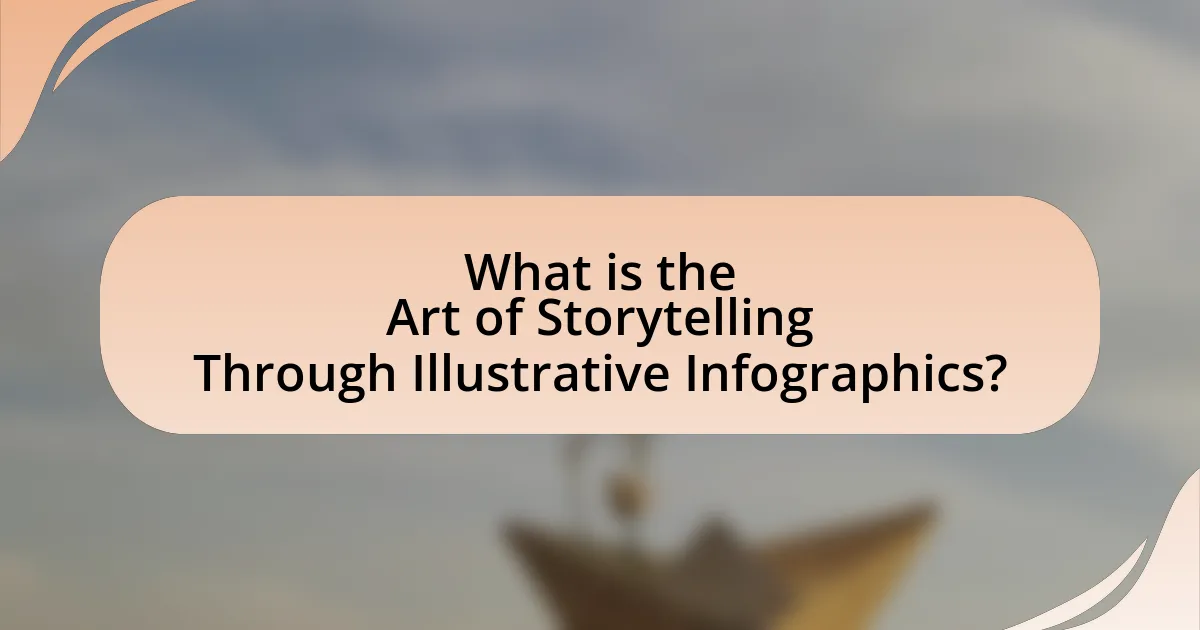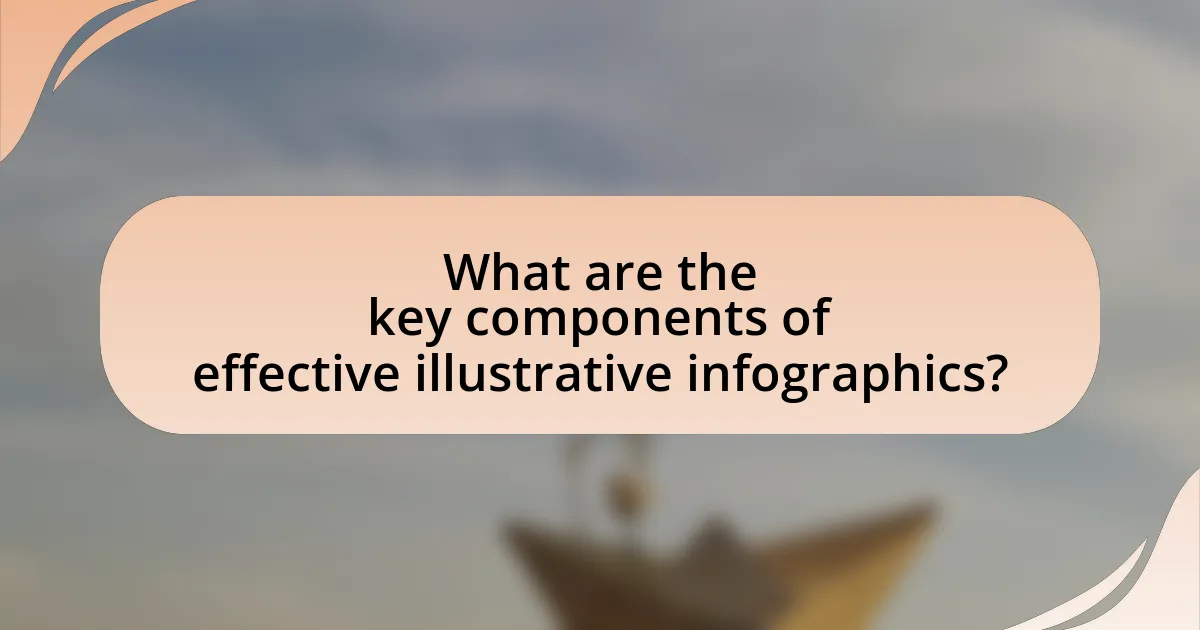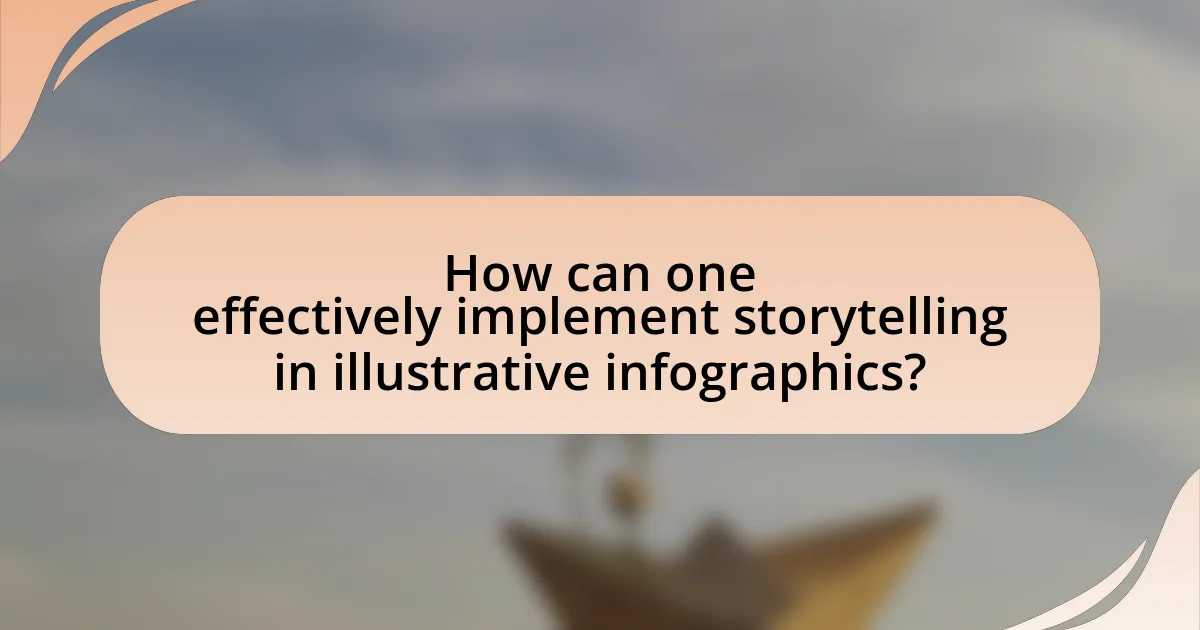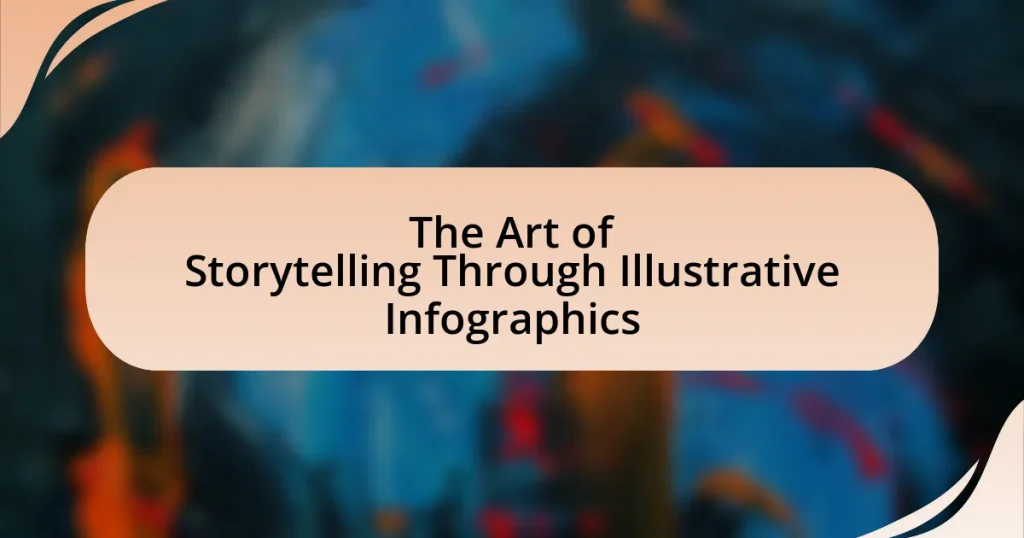The main entity of the article is the art of storytelling through illustrative infographics. The article explores how combining visual elements with narrative techniques enhances the communication of complex information, improving understanding and retention. It discusses the effectiveness of visuals in storytelling, the key components that make infographics engaging, and the role of design elements like color and typography in enhancing narrative comprehension. Additionally, it outlines best practices for creating compelling narratives in infographics, the importance of audience engagement, and common pitfalls to avoid in infographic storytelling. Overall, the article emphasizes the significance of storytelling in making data relatable and memorable.

What is the Art of Storytelling Through Illustrative Infographics?
The art of storytelling through illustrative infographics involves the effective combination of visual elements and narrative techniques to convey complex information in an engaging manner. This method enhances understanding and retention by utilizing visuals such as charts, icons, and images alongside concise text to create a cohesive story. Research indicates that visuals can improve comprehension by up to 400%, demonstrating the power of infographics in communication. By integrating storytelling principles, such as character development and conflict resolution, infographics can evoke emotional responses, making the information more relatable and memorable.
How do illustrative infographics enhance storytelling?
Illustrative infographics enhance storytelling by visually representing complex information, making it more accessible and engaging for the audience. By combining graphics, text, and data, these infographics simplify narratives and highlight key points, allowing viewers to grasp concepts quickly. Research indicates that visuals can increase information retention by up to 65%, demonstrating their effectiveness in communication. Furthermore, infographics can evoke emotions and create a narrative flow, guiding the audience through the story in a structured manner. This combination of clarity and emotional engagement makes illustrative infographics a powerful tool in storytelling.
What elements make an infographic effective in storytelling?
An effective infographic in storytelling incorporates clarity, visual appeal, and a coherent narrative structure. Clarity ensures that the information is easily understood, often achieved through concise text and straightforward visuals. Visual appeal engages the audience, utilizing colors, fonts, and images that attract attention and enhance comprehension. A coherent narrative structure guides the viewer through the information logically, often using a beginning, middle, and end format to create a compelling story. Research indicates that infographics that combine these elements can increase information retention by up to 65% compared to text alone, demonstrating their effectiveness in storytelling.
How does visual design influence narrative comprehension?
Visual design significantly influences narrative comprehension by enhancing the clarity and engagement of the story being told. Effective visual elements, such as color, typography, and layout, guide the viewer’s attention and help convey complex information more intuitively. Research indicates that well-designed visuals can improve retention and understanding; for instance, studies show that people remember information presented with relevant images 65% better than information presented in text alone. This demonstrates that visual design not only supports but also enriches the narrative, making it more accessible and memorable for the audience.
Why is storytelling important in infographics?
Storytelling is important in infographics because it enhances engagement and comprehension. By weaving a narrative into visual data, infographics can transform complex information into relatable and memorable content. Research indicates that people are 22 times more likely to remember a fact when it is part of a story, highlighting the effectiveness of storytelling in retaining information. Additionally, storytelling in infographics helps to create emotional connections, making the data more impactful and persuasive for the audience.
What role does narrative play in audience engagement?
Narrative plays a crucial role in audience engagement by creating an emotional connection that enhances understanding and retention of information. When narratives are employed, they transform data into relatable stories, making complex concepts more accessible and memorable. Research indicates that storytelling can increase information retention by up to 65% compared to traditional presentation methods. This effectiveness stems from the way narratives activate multiple areas of the brain, allowing audiences to visualize and empathize with the content, thereby fostering a deeper engagement with the material presented.
How can storytelling improve information retention?
Storytelling improves information retention by creating emotional connections and contextual frameworks that enhance memory recall. When information is presented as a narrative, it engages multiple cognitive processes, making it easier for individuals to remember details. Research indicates that stories activate the brain’s sensory and emotional centers, which can lead to a 22 times increase in recall compared to facts presented in isolation. This phenomenon is supported by a study published in the journal “Neuroscience,” which found that narratives stimulate the release of oxytocin, a hormone that fosters empathy and connection, further solidifying memory retention.

What are the key components of effective illustrative infographics?
Effective illustrative infographics consist of clear visuals, concise text, a logical flow of information, and a strong narrative. Clear visuals, such as charts and icons, enhance comprehension by simplifying complex data. Concise text ensures that the message is easily digestible, avoiding overwhelming the viewer. A logical flow organizes information in a way that guides the audience through the content seamlessly. Finally, a strong narrative ties all elements together, making the infographic not just informative but also engaging. Research indicates that infographics with these components significantly improve information retention and understanding among viewers.
How do visuals contribute to the storytelling process?
Visuals enhance the storytelling process by providing immediate context and emotional engagement. They allow audiences to grasp complex narratives quickly, as studies show that visuals can increase information retention by up to 65% compared to text alone. Additionally, visuals evoke emotions and create a stronger connection to the story, as evidenced by research from the University of California, which found that images can trigger emotional responses that enhance memory recall. Thus, incorporating visuals into storytelling not only aids comprehension but also deepens the audience’s emotional investment in the narrative.
What types of visuals are most effective for storytelling?
Effective visuals for storytelling include infographics, illustrations, photographs, and videos. Infographics combine data and visuals to simplify complex information, making it easier for audiences to grasp key messages quickly. Illustrations can evoke emotions and create a unique narrative style, enhancing engagement. Photographs capture real-life moments, adding authenticity and relatability to stories. Videos combine audio and visual elements, allowing for dynamic storytelling that can convey tone and emotion effectively. Research indicates that visuals can increase retention rates by up to 65%, demonstrating their power in enhancing storytelling.
How can color and typography enhance the narrative?
Color and typography enhance the narrative by creating emotional resonance and improving readability. Color can evoke specific feelings; for instance, blue often conveys calmness, while red can signify urgency or passion. Typography, through font choice and size, influences how information is perceived; a bold font can draw attention, while a serif font may lend an air of sophistication. Research shows that visual elements like color and typography can increase information retention by up to 65%, as they help to organize content and guide the viewer’s focus. This synergy between color and typography not only enriches the storytelling experience but also aids in effectively communicating the intended message.
What techniques can be used to create compelling narratives in infographics?
Compelling narratives in infographics can be created using techniques such as visual hierarchy, storytelling structure, and data visualization. Visual hierarchy guides the viewer’s attention through the infographic, emphasizing key points and ensuring clarity. Storytelling structure, which includes a clear beginning, middle, and end, helps to engage the audience and maintain their interest. Data visualization techniques, such as charts and graphs, effectively present complex information in an easily digestible format, making the narrative more impactful. These techniques are supported by research indicating that well-structured visual narratives enhance comprehension and retention of information, as demonstrated in studies on visual learning and cognitive processing.
How can data be transformed into a story through visuals?
Data can be transformed into a story through visuals by utilizing techniques such as infographics, charts, and graphs that effectively communicate complex information in an engaging manner. These visual tools help to highlight key trends, relationships, and insights within the data, making it easier for the audience to understand and retain the information. For instance, a study by the Nielsen Norman Group found that visuals can increase information retention by up to 65%, demonstrating the effectiveness of visual storytelling in conveying data-driven narratives.
What are the best practices for structuring an infographic narrative?
The best practices for structuring an infographic narrative include establishing a clear objective, organizing information logically, and using visual hierarchy effectively. A clear objective guides the narrative, ensuring that the infographic communicates a specific message or story. Organizing information logically involves grouping related data and presenting it in a sequence that flows naturally, which helps the audience understand the progression of ideas. Utilizing visual hierarchy, such as varying font sizes and colors, directs attention to the most important elements, enhancing comprehension and retention. Research indicates that well-structured infographics can increase information retention by up to 65%, demonstrating the effectiveness of these practices in conveying complex information succinctly.

How can one effectively implement storytelling in illustrative infographics?
To effectively implement storytelling in illustrative infographics, one should create a clear narrative structure that guides the viewer through the information. This involves defining a central theme or message, organizing data into a logical sequence, and using visual elements such as icons, colors, and typography to enhance the narrative. Research indicates that narratives improve information retention; for instance, a study by the University of California found that storytelling can increase recall by up to 22 times compared to non-narrative formats. By integrating these elements, infographics can convey complex information in an engaging and memorable way.
What steps should be taken to design an infographic with a strong narrative?
To design an infographic with a strong narrative, first, identify the core message or story you want to convey. This foundational step ensures that the infographic has a clear purpose and direction. Next, gather relevant data and information that supports this narrative, ensuring it is accurate and compelling. Organize the information logically, creating a flow that guides the viewer through the story, often using a beginning, middle, and end structure.
Incorporate visual elements such as charts, icons, and images that enhance understanding and engagement, aligning them with the narrative to create a cohesive visual story. Use color schemes and typography that reflect the tone of the narrative, ensuring consistency throughout the design. Finally, review and refine the infographic, seeking feedback to ensure that the narrative is clear and impactful. This process is supported by research indicating that well-structured visual narratives significantly improve information retention and viewer engagement.
How can one identify the target audience for the infographic?
To identify the target audience for an infographic, one must analyze demographic data, interests, and behaviors relevant to the subject matter. This involves researching the characteristics of potential viewers, such as age, gender, education level, and professional background, which can be gathered through surveys, social media analytics, and market research reports. For instance, a study by Pew Research Center indicates that understanding audience demographics can significantly enhance engagement, as tailored content resonates more effectively with specific groups. By aligning the infographic’s content and design with the identified audience’s preferences, creators can ensure that the message is both impactful and relevant.
What tools and software can assist in creating narrative-driven infographics?
Tools and software that assist in creating narrative-driven infographics include Canva, Piktochart, and Adobe Illustrator. Canva offers user-friendly templates and design elements that facilitate storytelling through visuals, making it accessible for non-designers. Piktochart provides a range of infographic templates specifically designed for narrative structures, allowing users to effectively convey information in a story format. Adobe Illustrator, while more complex, offers advanced design capabilities that enable detailed customization and professional-quality graphics, essential for creating compelling narratives. These tools are widely used in the industry, demonstrating their effectiveness in enhancing visual storytelling.
What common pitfalls should be avoided in infographic storytelling?
Common pitfalls to avoid in infographic storytelling include oversimplification, excessive text, poor design choices, and lack of a clear narrative. Oversimplification can lead to loss of essential information, making the infographic less informative. Excessive text can overwhelm viewers, detracting from the visual impact and engagement. Poor design choices, such as clashing colors or unreadable fonts, can hinder comprehension and distract from the message. Lastly, a lack of a clear narrative can confuse the audience, making it difficult for them to follow the intended story. These pitfalls can significantly diminish the effectiveness of an infographic in conveying information.
How can oversimplification undermine the narrative?
Oversimplification can undermine the narrative by stripping away essential complexities that provide depth and context. When a narrative is reduced to overly simplistic elements, it risks misrepresenting the subject matter, leading to misunderstandings or a lack of engagement from the audience. For instance, in storytelling through illustrative infographics, oversimplified visuals may fail to convey critical data nuances, resulting in a distorted interpretation of the information presented. This can diminish the overall effectiveness of the narrative, as audiences may draw incorrect conclusions or overlook important insights that are crucial for a comprehensive understanding of the topic.
What are the risks of using too much text in infographics?
Using too much text in infographics can lead to information overload, causing viewers to disengage or miss key messages. Research indicates that cognitive overload occurs when individuals are presented with excessive information, which can hinder comprehension and retention (Sweller, 1988). Additionally, infographics are designed to visually communicate data; an overabundance of text can clutter the visual space, making it difficult for the audience to quickly grasp the intended narrative. This clutter can detract from the overall effectiveness of the infographic, as studies show that visuals paired with minimal text enhance understanding and recall (Mayer, 2001).
What are some best practices for storytelling through illustrative infographics?
Best practices for storytelling through illustrative infographics include focusing on a clear narrative structure, using visual hierarchy, and incorporating relevant data. A clear narrative structure guides the audience through the information logically, ensuring that each element builds upon the previous one. Visual hierarchy, achieved through size, color, and placement, directs attention to the most important aspects of the story, making it easier for viewers to grasp key messages. Incorporating relevant data enhances credibility and provides context, as studies show that visuals paired with data can increase retention by up to 65%. These practices collectively enhance the effectiveness of infographics in conveying complex information succinctly and engagingly.
How can feedback improve the effectiveness of infographic storytelling?
Feedback enhances the effectiveness of infographic storytelling by providing insights into audience comprehension and engagement. When creators receive constructive criticism, they can identify which elements resonate with viewers and which do not, allowing for targeted improvements. For instance, studies show that infographics with clear visual hierarchies and concise text lead to better retention of information, as evidenced by research from the University of Massachusetts, which found that visual aids can increase information retention by up to 65%. By incorporating feedback, designers can refine their visuals and narratives, ensuring that the final product effectively communicates the intended message and engages the audience more successfully.
What tips can enhance the visual appeal and narrative clarity of infographics?
To enhance the visual appeal and narrative clarity of infographics, utilize a balanced combination of color, typography, and layout. Effective use of color can create visual hierarchy and guide the viewer’s attention, while consistent typography ensures readability and reinforces the message. A well-structured layout organizes information logically, making it easier for the audience to follow the narrative. Research indicates that infographics with a clear visual hierarchy can increase viewer engagement by up to 80%, demonstrating the importance of these design elements in effective storytelling.


